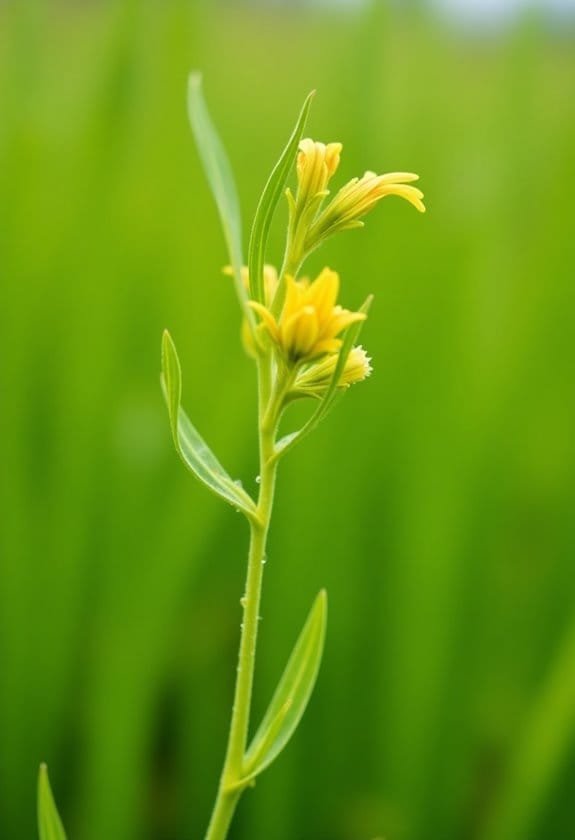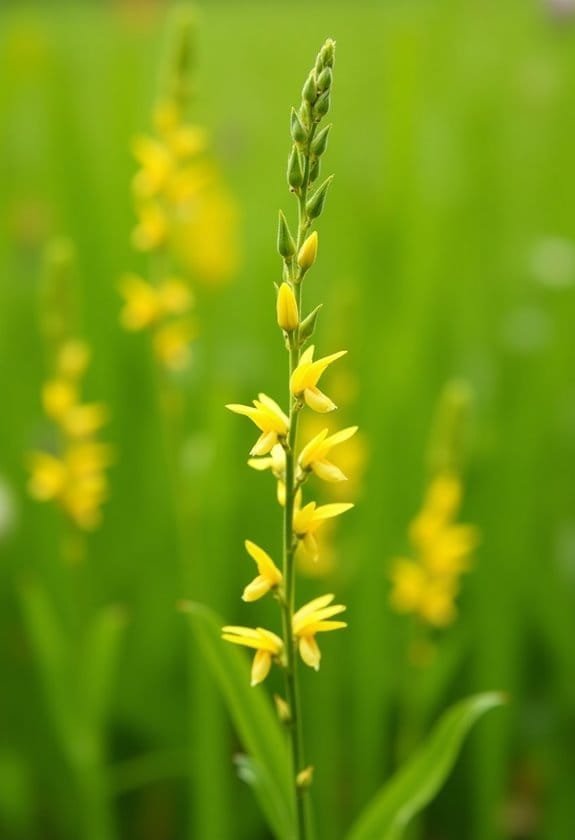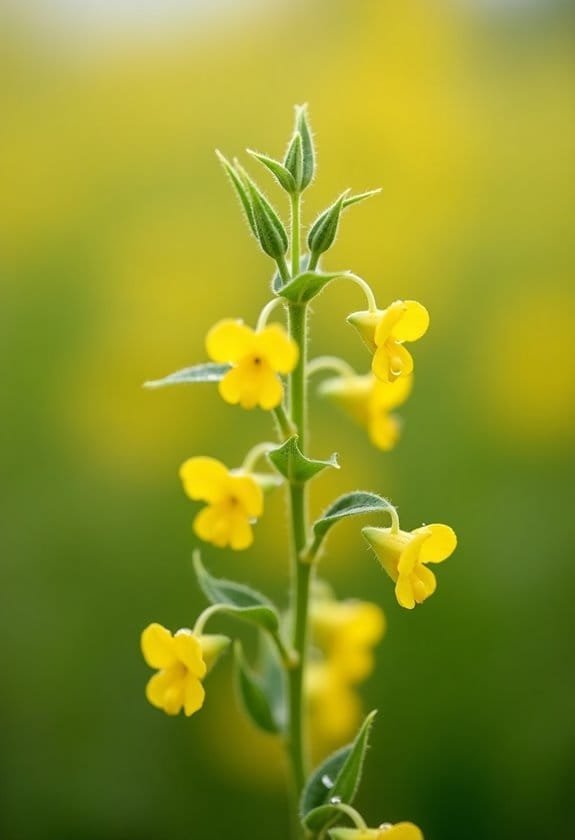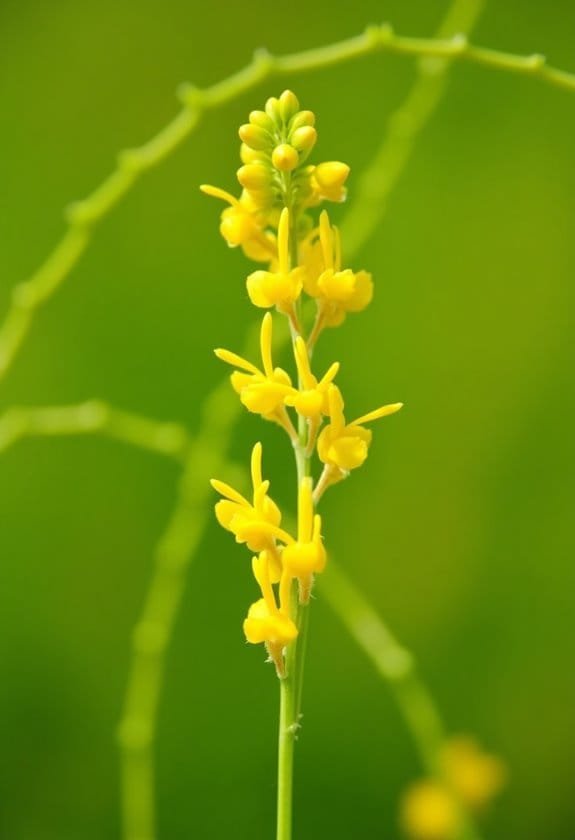Meadow vetchling is a hardy perennial herb that brightens meadows with its vibrant yellow, butterfly-shaped blooms from June through August. This member of the legume family (Fabaceae) reaches heights of 25-60 cm and features distinctive paired leaflets on climbing stems. It's prized for its nitrogen-fixing abilities, which enrich soil quality while supporting diverse pollinator populations, particularly bees and wasps. Native to Europe, Asia, and parts of North America, Lathyrus pratensis thrives in well-drained loamy soils with full sun to partial shade exposure. This ecological cornerstone's complex relationship with beneficial soil bacteria and pollinators reveals fascinating adaptations worth exploring.
Main Points
- Meadow vetchling is a perennial herb with bright yellow butterfly-shaped flowers that blooms from June to August in meadows and grasslands.
- The plant reaches heights of 25-60 cm, featuring compound leaves with paired leaflets and producing black seed pods containing 2-8 seeds.
- It belongs to the Fabaceae family and enriches soil through nitrogen fixation, making it valuable for ecosystem health and biodiversity.
- Thrives in well-drained soils with full sun to partial shade, requiring regular watering during flowering and pH levels between 6.0-7.5.
- Attracts important pollinators like bees and wasps, while its extensive root system helps prevent soil erosion in various habitats.
Introduction

Meadow vetchling (Lathyrus pratensis) stands as a remarkable perennial herb that brightens meadows and grasslands with its distinctive yellow blooms.
Its presence across Europe and Asia, and later introduction to parts of North America, has established this legume as a versatile plant adaptable to various habitats.
The plant's elegant structure, reaching heights of 25-60 cm, features compound leaves with paired leaflets and characteristic butterfly-shaped flowers that emerge in abundant clusters during the summer months.
Common Name
Lathyrus pratensis commonly goes by the name "Meadow Vetchling," though it's also known as "Meadow Pea" or "Fingers-and-thumbs" in various regions. These descriptive names reflect both the plant's habitat preferences and its distinctive physical characteristics, particularly its tendency to flourish in meadow environments.
The name "Meadow Vetchling" perfectly captures the plant's natural disposition, as it thrives in grassy areas and open meadowlands throughout its extensive range. Its bright yellow flowers, which emerge in clustered formations during the summer months from June to August, have influenced its recognition and naming across different cultures.
The alternative name "Fingers-and-thumbs" likely derives from the plant's unique leaf structure, which presents a distinctive arrangement reminiscent of human digits. As a member of the Fabaceae family, Meadow Pea shares characteristics with other legumes, including the ability to fix nitrogen in the soil.
This beneficial trait has contributed to its widespread distribution across Europe, Asia, and portions of North America, where it has established itself as a familiar sight in both natural and disturbed habitats.
Scientific Name
The scientific classification of this distinctive yellow-flowered plant is Lathyrus pratensis, belonging to the extensive Fabaceae family. This taxonomic placement reflects its relationship to other legumes, establishing its evolutionary connection to well-known plants like peas and beans.
In meadow habitats across various regions, this species demonstrates remarkable adaptability while maintaining its characteristic features. The specific epithet "pratensis" derives from the Latin word for meadow, aptly describing its preferred habitat.
The plant's morphological characteristics, including its bright yellow flowers arranged in clusters of 5-12 blooms, distinguish it from other members of the Lathyrus genus. Each flower measures 10-16 mm in length and displays the classic pea-flower structure with standard, wings, and keel petals.
The species exhibits distinctive vegetative features, particularly its compound leaves with a single pair of broad lanceolate leaflets. These botanical attributes, combined with its climbing habit reaching heights of 25 to 60 cm, make Lathyrus pratensis readily identifiable in the field.
The development of black seed pods further confirms its placement within the legume family's reproductive pattern.
Overview
Beyond its formal taxonomic classification, this vibrant yellow-flowered perennial has earned recognition as a versatile and adaptable member of meadow ecosystems. With its distinctive erect, hairy stem reaching heights between 25-60 cm, meadow vetchling commands attention in diverse habitats ranging from woodlands to disturbed landscapes.
The plant's architectural elegance is evident in its carefully arranged alternate leaves, which feature a single pair of broad lanceolate leaflets complemented by prominent stipules.
During its peak flowering period from June through August, the species produces striking inflorescences containing five to twelve yellow flowers, each measuring 10-16 mm in length and displaying a characteristically irregular structure. This flowering pattern makes it a beacon for pollinators in grassy areas and natural spaces.
Beyond its aesthetic appeal, meadow vetchling serves as an ecological cornerstone across its native European and Asian ranges, as well as in introduced territories like the northwestern United States.
The species contributes considerably to ecosystem health through its ability to fix nitrogen in the soil, while simultaneously supporting local biodiversity through its interactions with various pollinator species.
Key Features
Meadow vetchling stands as a striking perennial herb, reaching heights of 25-60 cm with its distinctive erect, hairy stem.
Its compound leaves feature a single pair of broad lanceolate leaflets complemented by prominent stipules, creating an elegant botanical architecture.
The plant's most enchanting feature appears from June through August, when clusters of 5-12 bright yellow flowers, each measuring 10-16 mm long, emerge in their characteristic butterfly formation.
Growth Size
Standing 25-60 centimeters (10-24 inches) tall, this perennial herb features erect, hairy stems and distinctive compound leaves. The growth characteristics of meadow vetchling demonstrate remarkable adaptability, allowing it to thrive in various environments while maintaining its characteristic upright posture.
This versatile plant exhibits notable height variation throughout its growing season, with mature specimens reaching their full potential during the summer months when flowering occurs. The plant's climbing behavior is facilitated by specialized tendrils, which enable it to ascend through surrounding vegetation and establish itself at higher positions within its habitat.
These tendrils, combined with the plant's substantial height range, make it an accomplished climber in meadow ecosystems. The vertical growth pattern is complemented by the plant's reproductive structures, including its distinctive bright yellow flowers measuring 10-16 millimeters in length, which appear in clusters of 5-12 blooms.
This growth strategy guarantees ideal visibility to pollinators while maintaining the structural integrity necessary to support its developing black seed pods, each containing 2-8 seeds.
Appearance
Distinguished by its erect, hairy stems and pea-like yellow flowers, Lathyrus pratensis showcases a unique combination of structural features. The plant's scrambling growth pattern allows it to reach impressive heights of 25-60 cm, while its alternate compound leaves create an elegant architectural presence in its preferred meadow habitats.
Throughout the growing season, the plant displays remarkable color variations, with its bright yellow flowers serving as striking beacons against the green foliage backdrop. Each flower cluster, comprising 5-12 individual blooms measuring 10-16 mm in length, exhibits intricate architectural complexity with its arrangement of five sepals, five petals, ten stamens, and a single carpel.
These blossoms undergo seasonal changes, flourishing from June through August, creating waves of golden color across grasslands.
The plant's distinctive appearance extends to its foliage, where broad lanceolate leaflets emerge in pairs, accompanied by significantly large stipules. As the season progresses, the development of long black pods, reminiscent of traditional garden peas, adds another layer to its visual character, containing between two and eight seeds within each pod.
Flowering Season
During peak summer months, Lathyrus pratensis transforms meadows with its vibrant display of yellow butterfly-shaped blooms from June through August. The flowering duration spans approximately twelve weeks, during which each inflorescence produces an impressive array of 5-12 individual flowers, measuring between 10-16 mm in length.
The plant's distinctive floral architecture features a complex arrangement of five sepals and five specialized petals, including a prominent standard petal, paired wing petals, and a protective keel structure. This intricate design serves as a remarkable example of pollinator attraction, drawing various beneficial insects, particularly bees and wasps, which are essential for successful reproduction during the blooming period.
As the flowering season progresses toward its conclusion, the plant undergoes a significant transformation focused on seed dispersal. The spent flowers develop into flattened, elongated pods, each housing between 2-8 seeds.
This reproductive strategy guarantees the species' continued survival and distribution throughout its native range, as the pods eventually release their contents to establish new populations in suitable habitats.
Growing Requirements

Meadow vetchling flourishes in well-drained, loamy or sandy soils where it can receive full sun to partial shade throughout the growing season.
The plant's remarkable adaptability allows it to thrive in nutrient-poor conditions through its nitrogen-fixing capabilities, while maintaining ideal growth with regular watering during its June-to-August flowering period.
This hardy perennial performs best when planted in spring or autumn, with plants spaced 30 centimeters apart to guarantee proper development and air circulation within the growing area.
Light
Like many sun-loving legumes, Lathyrus pratensis flourishes in full sun to partial shade conditions.
The plant's light requirements reflect its natural habitat preferences, making it particularly well-suited to open meadows and grassland environments where direct sunlight is abundant.
This adaptable species demonstrates remarkable light adaptation capabilities, allowing it to th
Soil
The soil conditions for Lathyrus pratensis play an essential role in its successful growth and development, with specific requirements for ideal performance. This versatile plant demonstrates a marked preference for well-drained soils, particularly those with loamy or sandy soil composition that maintains consistent moisture levels without becoming saturated.
The ideal soil moisture balance supports meadow vetchling's establishment phase, though the plant's resilient nature allows it to withstand periodic drought conditions once its root system is fully developed.
Regarding soil fertility, the plant's relationship with nitrogen-fixing bacteria creates a mutually beneficial environment, enriching the surrounding soil and supporting neighboring vegetation. The optimal pH range of 6.0 to 7.5 facilitates efficient nutrient uptake and promotes robust root development, contributing to the plant's overall vigor.
Meadow vetchling's adaptability to various soil conditions, including disturbed and anthropogenic environments, has enabled its successful colonization of diverse habitats such as meadows, fields, and roadside areas, where it continues to thrive and contribute to the ecosystem's health.
Water
Effective water management plays an essential role in cultivating Lathyrus pratensis successfully. While this versatile plant demonstrates remarkable adaptability to varying moisture conditions, implementing proper irrigation best practices guarantees ideal growth and flowering performance. The species' ability to thrive in both dry and moist environments makes it particularly responsive to strategic water conservation strategies.
During the critical blooming period from June through August, maintaining consistent soil moisture becomes paramount for robust flower development and subsequent seed pod formation. Moisture retention techniques, such as incorporating organic matter into the surrounding soil, considerably enhance the plant's ability to access water during drier periods.
While Meadow vetchling's natural resilience allows it to withstand brief periods of drought, regular watering schedules prove beneficial in regions with limited rainfall. Gardeners should monitor soil moisture levels carefully, adjusting irrigation frequency based on local climate conditions and seasonal variations.
This balanced approach to water management supports the plant's vigorous growth while preventing unnecessary stress, particularly during the warmest summer months when water demands typically increase.
Temperature
Beyond water requirements, understanding ideal temperature conditions guarantees successful cultivation of Meadow vetchling. The plant's temperature adaptation strategies reflect its temperate origins, thriving in moderate climates where temperatures maintain a comfortable range of 15°C to 25°C during the growing season.
The plant's response to temperature fluctuation effects demonstrates remarkable resilience within certain boundaries. While it can withstand occasional frost, extreme temperature variations or extended cold periods can hinder its establishment and growth potential.
The temperature range impact extends to soil conditions, where root development and germination perform effectively between 10°C and 20°C, creating a foundation for robust growth.
For gardeners cultivating Meadow vetchling, maintaining consistent temperatures proves essential for plant success. Like a well-tuned instrument, the plant performs best when temperatures remain within its preferred range, particularly during critical growth phases.
While adaptable to mild seasonal shifts, it flourishes in regions characterized by gentle winters and warm summers, where temperature patterns support its natural growth cycle and flowering processes.
Pollinator Criteria
Meadow vetchling's bright yellow flowers serve as natural beacons for pollinators, particularly bees and wasps, during their peak blooming period from June through August.
The plant's specialized flower structure, featuring distinctive standard, wing, and keel petals, creates an efficient landing platform that guides pollinators directly to the nectar source.
Its clustered inflorescences, containing up to twelve flowers each, maximize pollinator foraging efficiency while supporting local biodiversity through their nitrogen-enriched soil environment.
Attracted Pollinators
With its vibrant yellow butterfly-shaped blossoms, Lathyrus pratensis serves as an important nectar source for diverse pollinators during its summer flowering period. The plant's distinctive clusters of flowers, which bloom from June through August, create an inviting haven for various pollinator species, particularly bees and wasps seeking nutritious nectar rewards.
The remarkable pollinator diversity attracted to meadow vetchling stems from its highly accessible flower structure, which has evolved to facilitate efficient pollen transfer. Honeybees and bumblebees, drawn to the abundant nectar availability, are among the most frequent visitors to these golden blooms. Their systematic foraging behavior guarantees successful cross-pollination among neighboring plants, contributing to the species' reproductive success.
The ecosystem benefits of meadow vetchling extend beyond its immediate attraction to pollinators. By supporting numerous beneficial insects, this plant strengthens local biodiversity and enhances pollination services throughout its habitat.
The presence of these yellow-flowered plants creates a crucial link in the broader ecological network, sustaining pollinator populations that service surrounding flora.
Pollination Method
The pollination process of Lathyrus pratensis showcases a refined system that's evolved to match specific pollinator requirements. The flower structure features five distinct petals arranged in a butterfly-like formation, creating an efficient landing platform for visiting bees. This specialized architecture guides pollinators directly to the nectar source while guaranteeing contact with reproductive structures.
During the peak blooming months of June through August, the bright yellow clusters serve as prominent beacons for pollinators, maximizing the plant's reproductive potential. The flower's design facilitates a precise pollinator behavior pattern, where bees must position themselves in specific ways to access the nectar reward.
This positioning guarantees pollen transfer occurs consistently and effectively between flowers. As pollinators move between blooms, they contribute to cross-pollination, which enhances genetic diversity within meadow vetchling populations.
The successful transfer of pollen ultimately leads to seed development within the characteristic black pods, with each pod capable of nurturing between two and eight viable seeds. This efficient pollination mechanism demonstrates how the species has adapted to guarantee its continued survival through specialized pollinator partnerships.
Care & Maintenance

Meadow vetchling's care requirements focus on providing well-drained soil and abundant sunlight, while its nitrogen-fixing properties eliminate the need for additional fertilization.
Regular maintenance includes consistent watering during dry spells and the removal of spent blooms to encourage prolonged flowering throughout its June-to-August growing season.
Gardeners can enhance the plant's vigor by thinning dense patches to improve air circulation, and it pairs particularly well with native grasses and complementary wildflowers that share similar growing conditions.
Planting Tips
Growing healthy meadow vetchling starts with proper soil preparation and placement. Before initiating meadow vetchling propagation, conducting a thorough soil test will guarantee the pH falls within the ideal range of 6.0 to 7.5, which is vital for successful establishment.
Once soil testing confirms suitable conditions, selecting high-quality seeds from reliable sources becomes the next priority.
The timing of planting plays a pivotal role in the plant's development, with early spring and late autumn being the most favorable periods for sowing. Like many legumes, meadow vetchling seeds benefit from a natural cold period, which enhances their germination potential through vernalization.
When choosing a planting location, select an area that receives ample sunlight, though the plant can tolerate partial shade conditions. The soil should be well-draining to prevent waterlogging, which can compromise root health.
During the establishment phase, maintain consistent moisture levels without oversaturating the soil, particularly during the first growing season.
After flowering concludes in August, remove any dead or damaged growth to encourage robust development in subsequent seasons.
Ongoing Care
Maintaining vibrant meadow vetchling requires consistent attention to several key aspects of care throughout the growing season. Regular soil testing informs appropriate fertilization techniques, ensuring the plant receives ideal nutrients for robust growth and abundant flowering. Proper watering practices, particularly during dry spells, help sustain the plant's health while preventing water-related stress.
Implementing effective pruning strategies plays an essential role in managing this climbing perennial's growth habits. Regular deadheading of spent blooms encourages continuous flowering, while strategic trimming prevents the plant from becoming overly aggressive in garden settings.
These maintenance practices also support proper climbing behavior, allowing the vetchling to utilize surrounding structures or companion plants effectively.
To enhance plant health, gardeners should monitor sunlight exposure, ensuring their meadow vetchling receives adequate light while protecting it from harsh afternoon conditions in warmer climates.
While pest management isn't typically a significant concern for this hardy species, regular inspection helps identify potential issues before they become problematic. Maintaining well-draining soil conditions through appropriate amendments supports the plant's natural resistance to common garden challenges.
Suggested Companions
Successfully pairing companion plants with meadow vetchling enhances both soil health and garden aesthetics. Among the most beneficial companion planting benefits, combining this climbing legume with clover and other nitrogen-fixing plants creates a synergistic relationship that enriches the soil naturally.
Implementing effective pollinator attracting strategies involves grouping meadow vetchling with native wildflowers, which establishes a vibrant ecosystem supporting bees, butterflies, and other beneficial insects. The diverse array of blossoms not only attracts pollinators but also creates visual interest throughout the growing season.
For peak soil health enhancement, gardeners should select companions that share meadow vetchling's preference for well-drained, sunny locations. Installing trellises or support structures enables both meadow vetchling and its climbing companions to reach their full potential without competing for ground space.
Regular maintenance, including strategic weed control between companion plants, guarantees that all species receive adequate nutrients and sunlight. When properly planned, these plant partnerships create a self-sustaining community that strengthens the garden's ecological foundation while providing year-round visual appeal.
How Does Meadow Cranesbill Differ from Meadow Vetchling in Habitat and Growth?
Meadow cranesbill thrives in sunny meadows and well-drained soils, while meadow vetchling often prefers damp grasslands and hedgerows. The meadow cranesbill plant facts reveal its ability to grow up to 60 cm tall with striking violet-blue flowers, whereas meadow vetchling grows as a climbing herb with bright yellow blooms.
Common Issues
Meadow vetchling faces several common challenges, including aphid infestations that can stunt growth and bacterial infections that cause leaf spots.
Root rot becomes problematic in poorly-drained soils, while powdery mildew often appears during humid conditions, particularly when air circulation is restricted around the plants.
Natural solutions include introducing ladybugs for aphid control, improving drainage through soil amendments, and maintaining adequate spacing between plants to prevent disease spread.
Pests/Diseases
Throughout the growing season, several pests and diseases can impact the health of Lathyrus pratensis. Aphid management becomes essential as these small insects feed on the plant's sap, potentially causing significant damage to stems and leaves, which often results in stunted growth and diminished plant vigor. Effective monitoring and early intervention are fundamental to prevent severe infestations.
In humid conditions, fungal resistance plays an important role in protecting meadow vetchling from powdery mildew, which manifests as a distinctive white coating on leaf surfaces. This fungal disease can seriously impair the plant's photosynthetic capabilities, leading to reduced overall health and productivity.
Additionally, proper soil drainage proves critical in preventing root rot, a condition that causes the plant's foliage to yellow and wilt progressively. When left unchecked, this disease can prove fatal to the affected plants.
Leaf spot diseases present another significant challenge, creating dark lesions that compromise photosynthetic efficiency. To maintain healthy meadow vetchling populations, gardeners should implement regular monitoring routines and adopt cultural practices such as crop rotation and adequate spacing between plants.
Solutions
Effective management of common issues in Lathyrus pratensis requires a combination of preventive measures and targeted solutions. Sustainable practices play an essential role in maintaining healthy populations while preventing potential spread into sensitive ecological areas.
For soil stabilization challenges, implementing strategic planting patterns can maximize the plant's erosion control benefits while monitoring its growth boundaries through regular assessments.
Habitat preservation efforts should focus on creating designated zones where meadow vetchling can thrive without competing with vulnerable native species, ensuring a balanced ecosystem approach.
Community engagement proves vital in successful management strategies, particularly in areas where meadow vetchling serves multiple purposes, such as soil enrichment and pollinator support.
Local stakeholders can participate in monitoring programs to track the plant's distribution and impact on surrounding vegetation.
When competition with other species becomes a concern, selective pruning and controlled growth zones can help maintain ecological balance without sacrificing the beneficial nitrogen-fixing properties that make meadow vetchling valuable for soil improvement initiatives.
Summary

The distinctive yellow-flowered meadow vetchling (Lathyrus pratensis) stands out as a hardy perennial that grows between 25-60 cm tall. This European and Asian native has successfully established itself across diverse landscapes, particularly thriving in meadows, grasslands, and woodland edges throughout its native range and introduced territories in North America.
The plant's ecological benefits are substantial, contributing to ecosystem health through multiple mechanisms. Its symbiotic relationship with nitrogen-fixing bacteria enhances soil fertility, while its extensive root system helps prevent soil erosion in vulnerable areas.
The species' characteristic pea-like flowers, measuring 10-16 mm, serve as valuable nectar sources for various pollinators during their June to August blooming period. The plant's distinctive morphology, featuring compound leaves with a single pair of broad lanceolate leaflets and climbing tendrils, enables it to ascend neighboring vegetation efficiently.
In regions like New England, where it has become a common sight, meadow vetchling demonstrates remarkable habitat preferences, adapting well to disturbed areas while maintaining its role as a beneficial component of local ecosystems.


